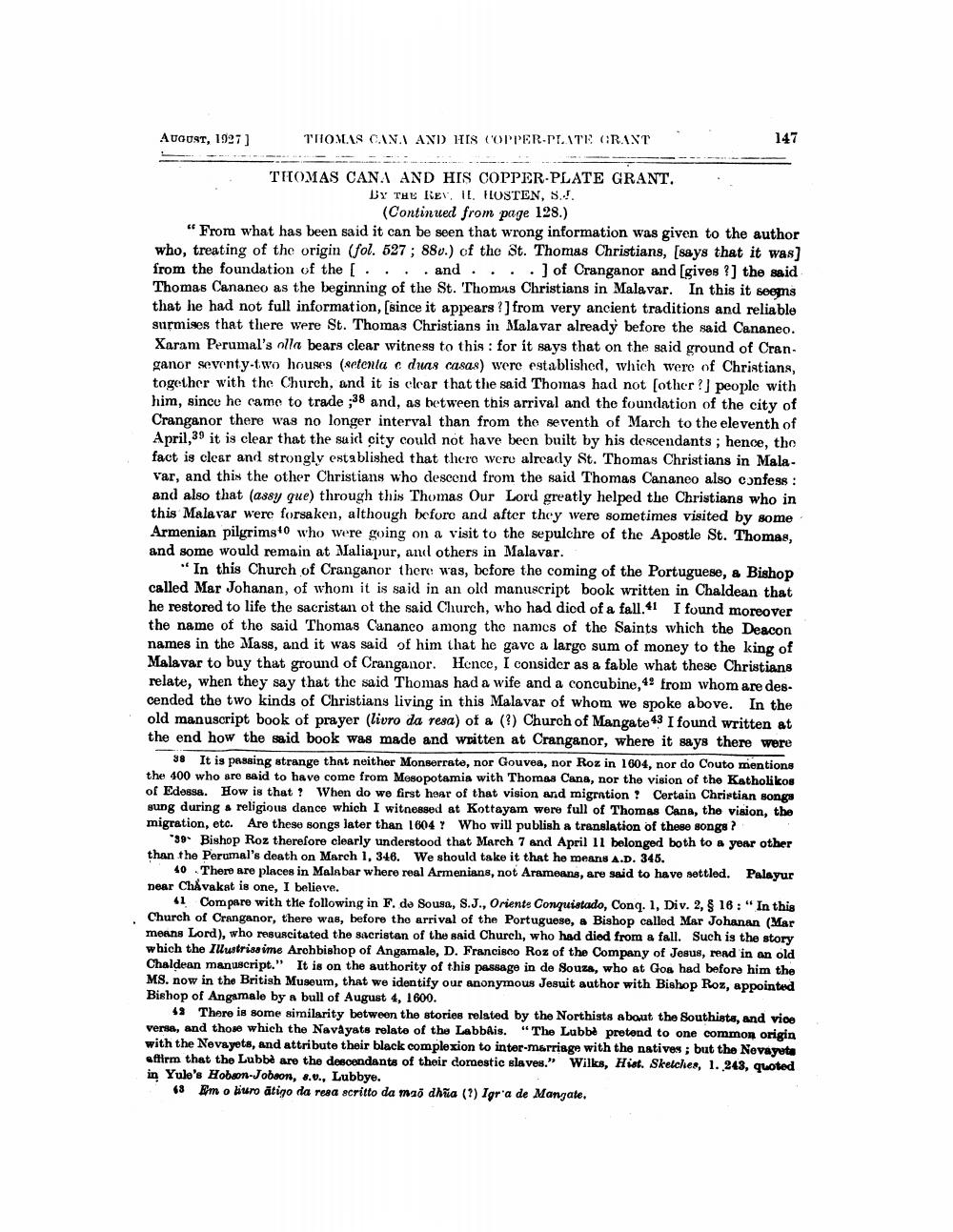________________
August, 1927]
THOMAS CAN AND HIS COPPER-SLATE (RAXT
147
THOMAS CANA AND HIS COPPER-PLATE GRANT.
BY THE REY, IL. FOSTEN, S.L.
(Continued from page 128.) "From what has been said it can be seen that wrong information was given to the author who, treating of the origin (fol. 527 ; 880.) of the St. Thomas Christians, [says that it was) from the foundation of the [... and...) of Cranganor and gives ?] the said Thomas Cananeo as the beginning of the St. Thomas Christians in Malavar. In this it seems that he had not full information, (since it appears ? ) from very ancient traditions and reliable surmises that there were St. Thomas Christians in Malavar already before the said Cananeo. Xaram Perumal's olla bears clear witness to this : for it says that on the said ground of Cran. ganor seventy-two houses (setenta c duas casas) were established, which were of Christians, together with the Church, and it is clear that the said Thomas had not (other?) people with him, since he came to trade ;38 and, as between this arrival and the foundation of the city of Cranganor there was no longer interval than from the seventh of March to the eleventh of April,39 it is clear that the said city could not have been built by his descendants ; hence, the fact is clear and strongly established that there were already St. Thomas Christians in Malavar, and this the other Christians who descend from the said Thomas Cananeo also confess : and also that (assy que) through this Thomas Our Lord greatly helped the Christians who in this Malavar were forsaken, although before and after they were sometimes visited by some Armenian pilgrimsto who were going on a visit to the sepulchre of the Apostle St. Thomas, and some would remain at Maliapur, and others in Malavar.
"In this Church of Cranganor there was, before the coming of the Portuguese, a Bishop called Mar Johanan, of whom it is said in an old manuscript book written in Chaldean that he restored to life the sacristan of the said Church, who had diod of a fall.41 I found moreover the name of the said Thomas Cananco among the names of the Saints which the Deacon names in the Mass, and it was said of him that he gave a large sum of money to the king of Malavar to buy that ground of Cranganor. Hence, I consider as a fable what these Christians relate, when they say that the said Thomas had a wife and a concubine, 4from whom are descended the two kinds of Christians living in this Malavar of whom we spoke above. In the old manuscript book of prayer (livro da resa) of a (?) Church of Mangate 43 I found written at the end how the said book was made and written at Cranganor, where it says there were
38 It is passing strange that neither Monserrate, nor Gouvea, nor Roz in 1604, nor do Couto mentions the 400 who are said to have come from Mesopotamia with Thomas Cana, nor the vision of the Katholikos of Edessa. How is that? When do we first hear of that vision and migration ! Certain Christian songs gung during a religious dance which I witnessed at Kottayam were full of Thomas Cana, the vision, the migration, etc. Are these songs later than 1604 ? Who will publish a translation of these songs?
39. Bishop Roz therefore clearly understood that March 7 and April 11 belonged both to a year other than the Perumal's death on March 1, 346. We should take it that he means A.D. 346.
40 There are places in Malabar where real Armenians, not Arameans, are said to have settled. Palayur near Chåvakat is one, I believe.
41 Compare with the following in F. de Sousa, S.J., Orients Conquistado, Conq. 1, Div. 2, § 16: "In this Church of Cranganor, there was, before the arrival of the Portuguese, a Bishop called Mar Johanan (Mar manns Lord), who resuscitated the sacristan of the said Church, who had died from a fall. Such is the story which the Illustrissime Archbishop of Angamale, D. Francisco Roz of the Company of Jesus, read in an old Chaldean manuscript." It is on the authority of this passage in de Souza, who at Gos had before him the MS. now in the British Museum, that we identify our anonymous Jesuit author with Bishop Roz, appointed Bishop of Angamale by a bull of August 4, 1600.
49 There is some similarity between the stories related by the Northists about the Southists, and vice verse, and those which the Navayats relato of the LabbAis. "The Lubbe pretend to one common origin with the Nevayets, and attribute their black complexion to inter-marriage with the natives; but the Nevayuta affirm that the Lubbe are the descendants of their domestic slaves." Wilks, Hist. Skelches, 1.243, quoted in Yule's Hobson-Jobson, 6.0., Lubbye.
68 Em o litro ätigo da resa scritto da mao dhia (1) Igra de Mangate.




